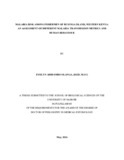| dc.description.abstract | Studies were conducted to determine whether capture fishing and associated activities place
individuals engaging in them at higher risk of contracting malaria. Consequently, a strategy was
developed to create awareness of malaria risk among fisherfolk using a behaviour change
monitoring and evaluation approach called Outcome Mapping. The first study sought to assess the
burden of malaria and determine indoor and outdoor transmission on Rusinga Island. Anopheles
arabiensis was found to be the most abundant malaria vector responsible for both indoor and
outdoor transmission. No significant difference in the density of An. arabiensis found indoors and
outdoors was observed (p = 0.477). Mosquitoes captured outdoors were found with sporozoites
which suggest that individuals conducting fishing activities outdoors at night are at risk of
receiving infectious bites. The prevalence of malaria was found to be 10.9% with P. falciparum as
the most prevalent parasite. As expected malaria was significantly associated with individuals who
did not use protective measures (Odds Ratio = 2.65, 95% Confidence Interval 1.76 – 3.91,
p<0.001).
Based on these results, the spatial and temporal exposure to malaria mosquitoes in relation to
fishing activities was conducted. Two peak mosquito biting times, revealing that fishermen found
outdoors at beaches during specific times are at risk of receiving infectious bites, were identified.
Anopheles arabiensis exhibited two biting peaks specifically between 10 - 11pm and 4 – 5am. Two
peaks in capture fishing activity, which coincided with the peaks in mosquito biting patterns, were
also observed. Of the total persons observed at the beach, 18.8% were counted between 9 – 10pm
and 49.7% between 3 – 7am. No significant difference was found in the density of An. arabiensis
at various distances from the shoreline. Compared to mosquitoes captured at close proximity to
the shoreline, there was no significant difference in the numbers of An. arabiensis caught at 600 –
1200 metres (p = 0.534) and 1200 - 1800 metres (p = 0.742) away. Compared to individuals who
live less than 600 metres from the shoreline, other individuals who lived 600 – 1200 metres (p =
0.319) and 1200 – 1800 metres (p = 0.312) away were not at a higher risk of malaria as measured
by parasite prevalence.
Another investigation sought to characterize malaria prevalence among outpatients in health
facilities and determine the association of the disease to individuals engaged in various livelihoods
on the Island. A health facility-based survey revealed that fishermen and farmers were significantly
xvi
associated with malaria cases. Among patients engaged in different livelihoods, malaria was
significantly associated with farmers (p = 0.003), and fishermen (p = 0.031) when compared to
adults who were unemployed.
Based on these results, a study was carried out to assess risk factors for malaria infection among
fishermen. The study provided knowledge regarding current behaviours exhibited by fishermen
that aggravate malaria control. The risk of contracting malaria was three-fold among fishermen
who conducted fishing activities in clothes that exposed their arms and legs (95% CI 1.11 – 14.23,
p = 0.045) compared to those who dressed in long sleeved clothes. Bednets were not found to be
an effective malaria control tool among fishermen since no difference in malaria infection was
found among fishermen who used bednets as a personal malaria protection measure or not (OR =
0.38, 95% CI 0.05 – 1.45, p = 0.218).
The final study used an outcome mapping approach to measure malaria prevention behaviour
change among pre-trained fisherfolk on Rusinga Island. A health intervention to create awareness,
educate and foster behaviour change was implemented among fisherfolk. The most significant
change was observed in attendance of project meetings by project partners. Most of the malaria
prevention and control efforts focused on use of treated bed nets and wearing long-sleeved clothing
outdoors.
In conclusion, the fishermen of Rusinga Island are at risk of contracting malaria because of a
temporal convergence between their outdoor activities and peak mosquito biting times. In addition,
they are at risk because they do not frequently sleep under treated bednets. Outcome mapping can
be used as a tool to demonstrate malaria prevention behaviour change among fisherfolk. | en_US |



